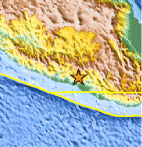
© US Geological Survey
Friday, July 17, 2009 at 14:45:44 UTC
Friday, July 17, 2009 at 09:45:44 AM at epicenter
Location:
16.838°N, 98.686°W
Depth:
10 km (6.2 miles) set by location program
Distances:115 km (75 miles) SE of Chilpancingo, Guerrero, Mexico
130 km (80 miles) E of Acapulco, Guerrero, Mexico
145 km (90 miles) SW of Huajuapan de Leon, Oaxaca, Mexico
290 km (180 miles) S of MEXICO CITY, D.F., Mexico
Comment: 13 minutes preceding this quake, there was another 4.5 magnitude in the same vicinity, although much deeper than this earthquake.